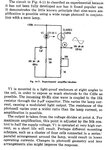neazoi
Advanced Member level 6
Here is an experiment of an LDR used as an amplifier.
It uses a neon tube, but a common LED can be used, improving efficiency possibly.
I have done this using a LED and it amplifies.
The drawback is the slow response of the LDR, so it is suitable only for low end audio ranges.
However, very big voltage amplification should be expected, as a low energy light source could vary "modulate" a possibly high voltage.
Any comments, or other similar circuits?
It uses a neon tube, but a common LED can be used, improving efficiency possibly.
I have done this using a LED and it amplifies.
The drawback is the slow response of the LDR, so it is suitable only for low end audio ranges.
However, very big voltage amplification should be expected, as a low energy light source could vary "modulate" a possibly high voltage.
Any comments, or other similar circuits?
